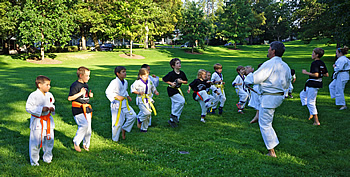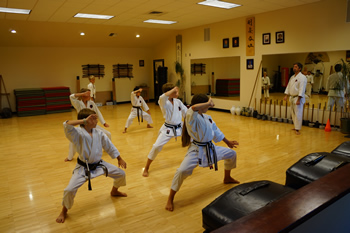 Karate in general, and Goju-Ryu in particular, is highly beneficial to all people, no matter what their age. Traditionally, Karate was restricted to only those lucky enough to have a personal introduction to the master, and to have been lucky enough to be accepted. At the turn of the century in Japan, Karate was opened up to the general population through the public high school system, and eventually private dojos started to accept adults and children alike, but maintained a minimum age requirement for children. In recent years it has become apparent that even very young children can reap the benefits that Karate has to offer. But in order to achieve this, the way in which Karate is taught must be adapted to the special needs of this age group.
Karate in general, and Goju-Ryu in particular, is highly beneficial to all people, no matter what their age. Traditionally, Karate was restricted to only those lucky enough to have a personal introduction to the master, and to have been lucky enough to be accepted. At the turn of the century in Japan, Karate was opened up to the general population through the public high school system, and eventually private dojos started to accept adults and children alike, but maintained a minimum age requirement for children. In recent years it has become apparent that even very young children can reap the benefits that Karate has to offer. But in order to achieve this, the way in which Karate is taught must be adapted to the special needs of this age group.
Junior Karate Class Schedule
Beginners
Monday and Wednesday 5-5:50 pm
Intermediate/Advanced
Tuesday and Thursday 5-5:50 pm
All Ranks
Saturday 9-9:50 am
Teaching Goals for Children
Self Defense
It is a sad but true fact of life that the society in which our children are growing has become an increasingly violent one. Therefore, it is important for us as educators to provide them with the skills and understanding to protect themselves. Our program teaches simple safety rules and preventative measures along with specific defensive techniques, so that the children learn to recognize a dangerous situation in order to avoid being trapped in it.
Physical Fitness
This is an important aspect of a child’s training. Coordination, strength, speed, and power are skills developed through our program, and are not only great for a child’s overall health, but can also cross over into other types of exercise and sports. These benefits are also closely related to a child’s self- esteem, which is crucial in the athletic conscious world of elementary and middle school.
Respect / Etiquette / Attitude
Children who study karate learn respect, self-control, and increased concentration. This confidence can be especially helpful in dealing with peer pressure. Our programs are also designed to teach children to better interact with each other, which is especially helpful for shy children, helping them improve their social skills.
A Typical Class
Warm Up
This is the first step in a karate class. Stretching exercises are performed to warm up the joints, tendons and muscle groups. Usually lasting about 5-10 minutes, these stretches start with the toes and work upward, finishing with the neck exercises.
Conditioning
After finishing the warm up we follow with some strength and conditioning exercises usually broken down into upper, mid, and lower body routines. These exercises are done at a gradual pace so that over the course of time the child’s body becomes stronger and has greater cardiovascular circulation. This builds their ability to develop their karate technique to full potential. Typical exercises include push ups, sit ups, and squats.
Basics (Kihon)
Having stretched out and warmed up, the class turns to the true foundation of your karate training: basic techniques. This is where students learn all the building blocks of karate: kicks and footwork, locks and throws, and punches and blocks. These are practiced in four basic fashions: stationary, moving, with a partner, and single and combination techniques.
Forms (Kata)
The central component of Goju-Ryu Karate, Kata are prearranged forms that allow a student to practice alone, and appreciate the interaction of numerous basic techniques. As students progress they are taught more intricate and complex kata. These forms have been handed down from century to century and can be practiced one’s whole life. Within the movements of a kata are many “bunkai” or self-defense applications that can be broken down and practiced with a partner. Kata is a concrete manifestation of technique, embodying the essence of traditional Karate.
Power / Stamina Training
We use punch bags, focus pads, and focus mitts to develop and feel power. In karate many combinations of kicks and punches can be practiced on the pads. This is an excellent way to develop stamina, distance, and power and tone the body.
Free Sparring / Self Defense
This is something that some students like and some prefer not to participate in. It’s up to the individual. Kumite, or sparring, is the ultimate cardiovascular workout – you will break a real sweat during these classes. Sparring develops your understanding of the distance and timing needed for offensive and defensive movement in a loose, non-contact format. Protective equipment is worn by all participants and is practiced in a safe and controlled atmosphere. Free sparring is also excellent self-defense training. Not only does it help build one’s confidence, it helps one develop the physical and emotional reactions needed to deal with a potentially violent situation on the streets.
Mental Development
The psychological benefits of confidence, focus, and discipline are just a few of the areas that transcend karate training to improve a student’s everyday life. The same self-discipline and concentration that children learn through karate training can be applied to schoolwork which often pays off in the form of better grades, or hobbies such as team sports and music. Karate also builds confidence and self-esteem, which give children the courage to say NO in the face of peer pressure. Children who practice karate have a proven track record of being polite, well-mannered, and emotionally balanced individuals who feel like positive and constructive members of society.

